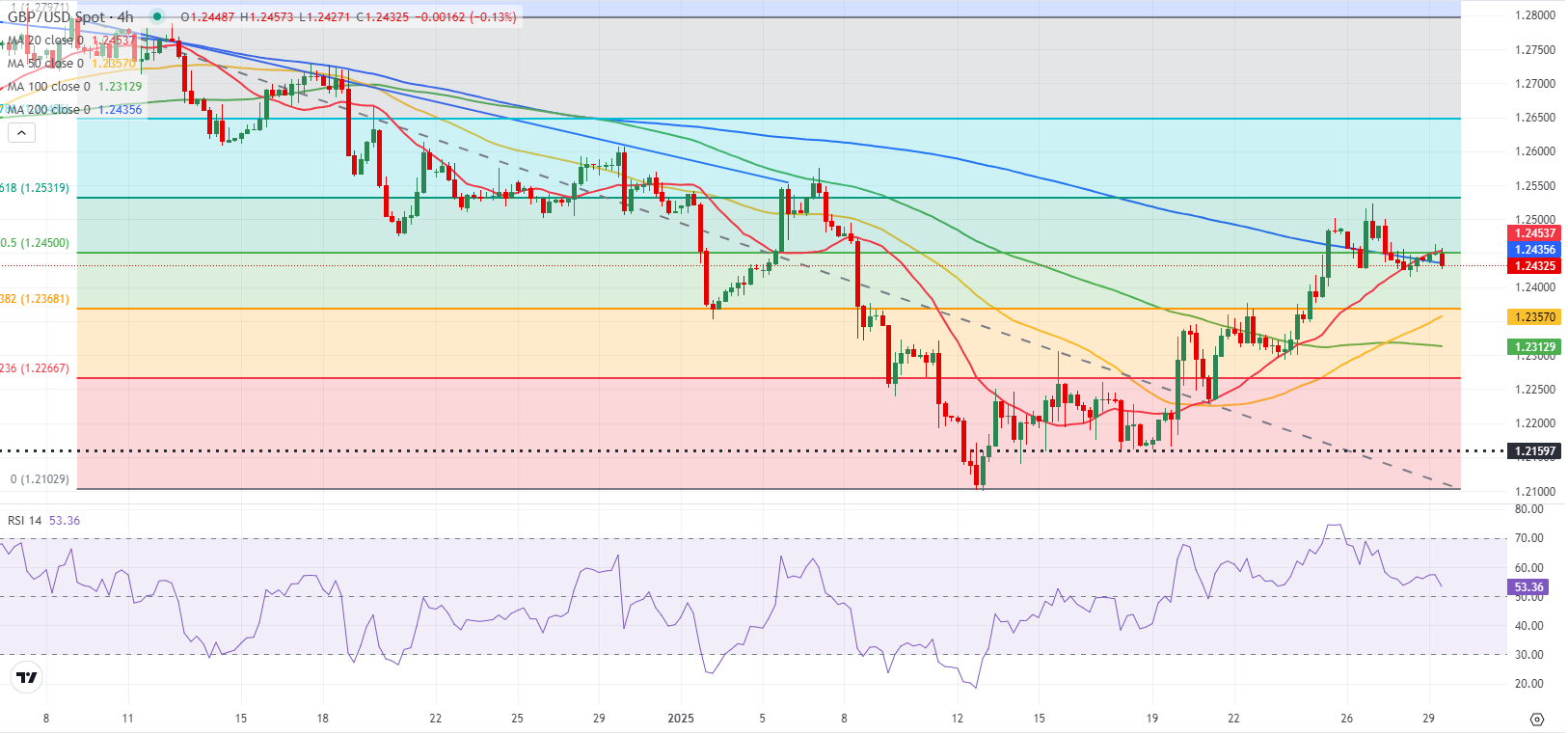GBP/USD Forecast: Pivot level forms at 1.2450, eyes on Fed
Premium|
You have reached your limit of 5 free articles for this month.
Get all exclusive analysis, access our analysis and get Gold and signals alerts
Elevate your trading Journey.
UPGRADE- GBP/USD continues to fluctuate in a narrow channel at around 1.2450.
- The Fed is set to leave the interest rate unchanged after the policy meeting.
- Fed Chairman Powell's comments could drive the USD's valuation.
After snapping a three-day winning streak on Tuesday, GBP/USD stays in a consolidation phase at around 1.2450 in the European session on Wednesday. Investors are likely to refrain from taking large positions ahead of the Federal Reserve's (Fed) monetary policy announcements.
The negative shift seen in risk mood helped the US Dollar (USD) outperform its rivals and forced GBP/USD to stay on the back foot on Tuesday.
Investors remain anxious about the uncertainty surrounding the Trump administration's trade policy. While speaking to reporters late Tuesday, US President Donald Trump's press secretary Karoline Leavitt said that the plan to impose Canada and Mexico with punishing tariffs on February 1 was still in play.
The Fed is widely expected to maintain the interest rate at 4.25%-4.5% following the January policy meeting. According to the CME FedWath Tool, markets see a nearly 33% probability of a 25 basis points rate cut in March. Hence, Fed Chairman Jerome Powell's comments on the policy outlook could drive the USD's valuation.
In case Powell reiterates the need for patience regarding further policy-easing and note that they will continue to watch data and assess the potential impact of new economic policies on prices and growth outlook, the immediate reaction could support the USD. On the flip side, investors could lean towards a March rate cut and trigger a selloff in the USD if Powell sounds more optimistic about inflation, noting the fact that Trump refrained from announcing day-one tariffs.
GBP/USD Technical Analysis
A key pivot level for GBP/USD aligns at 1.2450, where the Fibonacci 50% retracement level of the latest downtrend and the 200-period Simple Moving Average (SMA) align.
In case GBP/USD confirms 1.2450 as resistance, 1.2400 (static level, round level) could be seen as next support before 1.2370 (Fibonacci 38.2% retracement) and 1.2310 (100-period SMA). On the upside, resistances could be spotted at 1.2500 (round level, static level) and 1.2530 (Fibonacci 61.8% retracement).
Pound Sterling FAQs
The Pound Sterling (GBP) is the oldest currency in the world (886 AD) and the official currency of the United Kingdom. It is the fourth most traded unit for foreign exchange (FX) in the world, accounting for 12% of all transactions, averaging $630 billion a day, according to 2022 data. Its key trading pairs are GBP/USD, also known as ‘Cable’, which accounts for 11% of FX, GBP/JPY, or the ‘Dragon’ as it is known by traders (3%), and EUR/GBP (2%). The Pound Sterling is issued by the Bank of England (BoE).
The single most important factor influencing the value of the Pound Sterling is monetary policy decided by the Bank of England. The BoE bases its decisions on whether it has achieved its primary goal of “price stability” – a steady inflation rate of around 2%. Its primary tool for achieving this is the adjustment of interest rates. When inflation is too high, the BoE will try to rein it in by raising interest rates, making it more expensive for people and businesses to access credit. This is generally positive for GBP, as higher interest rates make the UK a more attractive place for global investors to park their money. When inflation falls too low it is a sign economic growth is slowing. In this scenario, the BoE will consider lowering interest rates to cheapen credit so businesses will borrow more to invest in growth-generating projects.
Data releases gauge the health of the economy and can impact the value of the Pound Sterling. Indicators such as GDP, Manufacturing and Services PMIs, and employment can all influence the direction of the GBP. A strong economy is good for Sterling. Not only does it attract more foreign investment but it may encourage the BoE to put up interest rates, which will directly strengthen GBP. Otherwise, if economic data is weak, the Pound Sterling is likely to fall.
Another significant data release for the Pound Sterling is the Trade Balance. This indicator measures the difference between what a country earns from its exports and what it spends on imports over a given period. If a country produces highly sought-after exports, its currency will benefit purely from the extra demand created from foreign buyers seeking to purchase these goods. Therefore, a positive net Trade Balance strengthens a currency and vice versa for a negative balance.
- GBP/USD continues to fluctuate in a narrow channel at around 1.2450.
- The Fed is set to leave the interest rate unchanged after the policy meeting.
- Fed Chairman Powell's comments could drive the USD's valuation.
After snapping a three-day winning streak on Tuesday, GBP/USD stays in a consolidation phase at around 1.2450 in the European session on Wednesday. Investors are likely to refrain from taking large positions ahead of the Federal Reserve's (Fed) monetary policy announcements.
The negative shift seen in risk mood helped the US Dollar (USD) outperform its rivals and forced GBP/USD to stay on the back foot on Tuesday.
Investors remain anxious about the uncertainty surrounding the Trump administration's trade policy. While speaking to reporters late Tuesday, US President Donald Trump's press secretary Karoline Leavitt said that the plan to impose Canada and Mexico with punishing tariffs on February 1 was still in play.
The Fed is widely expected to maintain the interest rate at 4.25%-4.5% following the January policy meeting. According to the CME FedWath Tool, markets see a nearly 33% probability of a 25 basis points rate cut in March. Hence, Fed Chairman Jerome Powell's comments on the policy outlook could drive the USD's valuation.
In case Powell reiterates the need for patience regarding further policy-easing and note that they will continue to watch data and assess the potential impact of new economic policies on prices and growth outlook, the immediate reaction could support the USD. On the flip side, investors could lean towards a March rate cut and trigger a selloff in the USD if Powell sounds more optimistic about inflation, noting the fact that Trump refrained from announcing day-one tariffs.
GBP/USD Technical Analysis
A key pivot level for GBP/USD aligns at 1.2450, where the Fibonacci 50% retracement level of the latest downtrend and the 200-period Simple Moving Average (SMA) align.
In case GBP/USD confirms 1.2450 as resistance, 1.2400 (static level, round level) could be seen as next support before 1.2370 (Fibonacci 38.2% retracement) and 1.2310 (100-period SMA). On the upside, resistances could be spotted at 1.2500 (round level, static level) and 1.2530 (Fibonacci 61.8% retracement).
Pound Sterling FAQs
The Pound Sterling (GBP) is the oldest currency in the world (886 AD) and the official currency of the United Kingdom. It is the fourth most traded unit for foreign exchange (FX) in the world, accounting for 12% of all transactions, averaging $630 billion a day, according to 2022 data. Its key trading pairs are GBP/USD, also known as ‘Cable’, which accounts for 11% of FX, GBP/JPY, or the ‘Dragon’ as it is known by traders (3%), and EUR/GBP (2%). The Pound Sterling is issued by the Bank of England (BoE).
The single most important factor influencing the value of the Pound Sterling is monetary policy decided by the Bank of England. The BoE bases its decisions on whether it has achieved its primary goal of “price stability” – a steady inflation rate of around 2%. Its primary tool for achieving this is the adjustment of interest rates. When inflation is too high, the BoE will try to rein it in by raising interest rates, making it more expensive for people and businesses to access credit. This is generally positive for GBP, as higher interest rates make the UK a more attractive place for global investors to park their money. When inflation falls too low it is a sign economic growth is slowing. In this scenario, the BoE will consider lowering interest rates to cheapen credit so businesses will borrow more to invest in growth-generating projects.
Data releases gauge the health of the economy and can impact the value of the Pound Sterling. Indicators such as GDP, Manufacturing and Services PMIs, and employment can all influence the direction of the GBP. A strong economy is good for Sterling. Not only does it attract more foreign investment but it may encourage the BoE to put up interest rates, which will directly strengthen GBP. Otherwise, if economic data is weak, the Pound Sterling is likely to fall.
Another significant data release for the Pound Sterling is the Trade Balance. This indicator measures the difference between what a country earns from its exports and what it spends on imports over a given period. If a country produces highly sought-after exports, its currency will benefit purely from the extra demand created from foreign buyers seeking to purchase these goods. Therefore, a positive net Trade Balance strengthens a currency and vice versa for a negative balance.
Information on these pages contains forward-looking statements that involve risks and uncertainties. Markets and instruments profiled on this page are for informational purposes only and should not in any way come across as a recommendation to buy or sell in these assets. You should do your own thorough research before making any investment decisions. FXStreet does not in any way guarantee that this information is free from mistakes, errors, or material misstatements. It also does not guarantee that this information is of a timely nature. Investing in Open Markets involves a great deal of risk, including the loss of all or a portion of your investment, as well as emotional distress. All risks, losses and costs associated with investing, including total loss of principal, are your responsibility. The views and opinions expressed in this article are those of the authors and do not necessarily reflect the official policy or position of FXStreet nor its advertisers.
